Materials Horizons Advisory Board member, Jean-Luc Brédas, is the author of the journal’s first Focus article, Mind the gap! Focus articles are educational pieces, intended to explain or clarify topics relevant to the understanding of materials science. In his article, Professor Brédas seeks to clear up the confusion surrounding the many types of energy gap relevant to organic materials, and calls for a more rigorous use of the appropriate terminology. Here we find out more about the author, and why he chose to write this article for Materials Horizons.
 Jean-Luc Brédas is Regents’ Professor of Chemistry and Biochemistry at Georgia Institute of Technology. He began his research career at the Université de Namur, Belgium, where he completed a Ph.D. in Theoretical Chemistry. Since then, he has held positions at Université de Mons, Belgium, the University of Arizona, USA, and King Abdulaziz University in Saudi Arabia. He is the author or co-author of over 950 scientific papers and has presented over 500 invited talks at scientific meetings and seminars.
Jean-Luc Brédas is Regents’ Professor of Chemistry and Biochemistry at Georgia Institute of Technology. He began his research career at the Université de Namur, Belgium, where he completed a Ph.D. in Theoretical Chemistry. Since then, he has held positions at Université de Mons, Belgium, the University of Arizona, USA, and King Abdulaziz University in Saudi Arabia. He is the author or co-author of over 950 scientific papers and has presented over 500 invited talks at scientific meetings and seminars.
Professor Brédas has been awarded numerous prizes in recognition of his work, including the Triennal Prize of the Royal Society of Chemistry, Belgium, (1991), the Francqui Prize (1997), the Descartes Prize of the European Commission (2003) and the Georgia Institute of Technology Outstanding Faculty Research Author Award (2008). In 2013, he received the American Physical Society David Adler Lectureship Award in Materials Physics. He has been a Fellow of the Royal Society of Chemistry since 2008.
The research activities of Professor Brédas’ group are focused on the computational characterization and design of novel organic materials of relevance for organic electronics and photonics.
What was the motivation to write your Materials Horizons Focus article?
There were two major reasons: The first is the original concept behind these Focus articles, which I believe is unique to Materials Horizons. The second is that many of my colleagues and myself were becoming increasingly frustrated by the lack of rigor surrounding the use of common terminologies in materials research articles, in particular with regard to energy gaps and energy levels in electro-active organic materials. Hence, when Seth Marder came to me with a proposition to write such a Focus article, he met no resistance!
At which upcoming conferences may our readers meet you?
In the spring, I’ll participate in SPIE Photonics West in San Francisco, the ACS National Meeting in Dallas, and the MRS Spring Meeting (again in San Francisco).
How do you spend your spare time?
Soccer, or should say much more appropriately football, is my main passion besides science. I still try to play as much as I can especially with my students. Also, I very much enjoy tending to the four fish tanks I have at home, with fish (cichlids) mainly from the Central Africa Lakes: Tanganyika and Malawi.
Which profession would you choose if you were not a scientist?
This is a tough question because I cannot picture myself doing something else really. The fulfillment that scientific research, teaching students, and making friends all over the world bring, would be in my mind very difficult to match. But to answer the question, maybe I’d like to be in the sports business, for instance as a commentator.
Jean-Luc Brédas
Mater. Horiz., 2014, 1, 17-19
DOI: 10.1039/C3MH00098B
‘The energy gap is a critical material parameter. Here, we illustrate the concepts behind the various flavors of energy gaps relevant for organic materials and call for a more consistent use of appropriate terminologies and procedures.’
Follow the latest journal news on Twitter @MaterHoriz or go to our Facebook page.


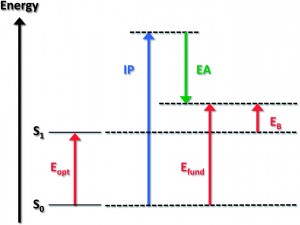









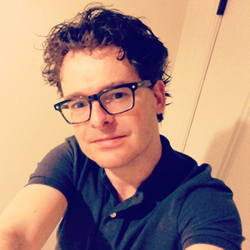
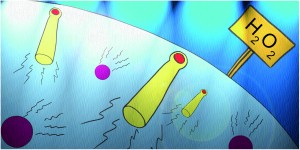 Chemotaxis of catalytic silica–manganese oxide “matchstick” particles
Chemotaxis of catalytic silica–manganese oxide “matchstick” particles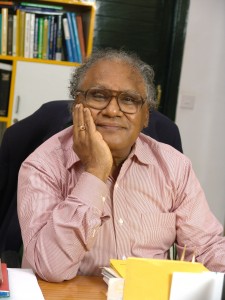
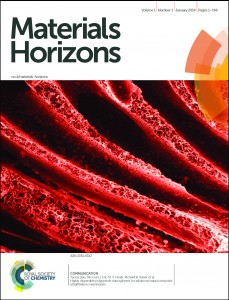
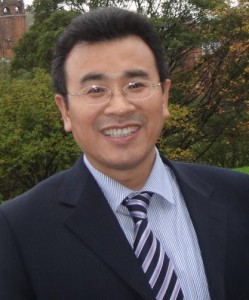

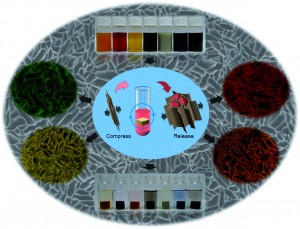
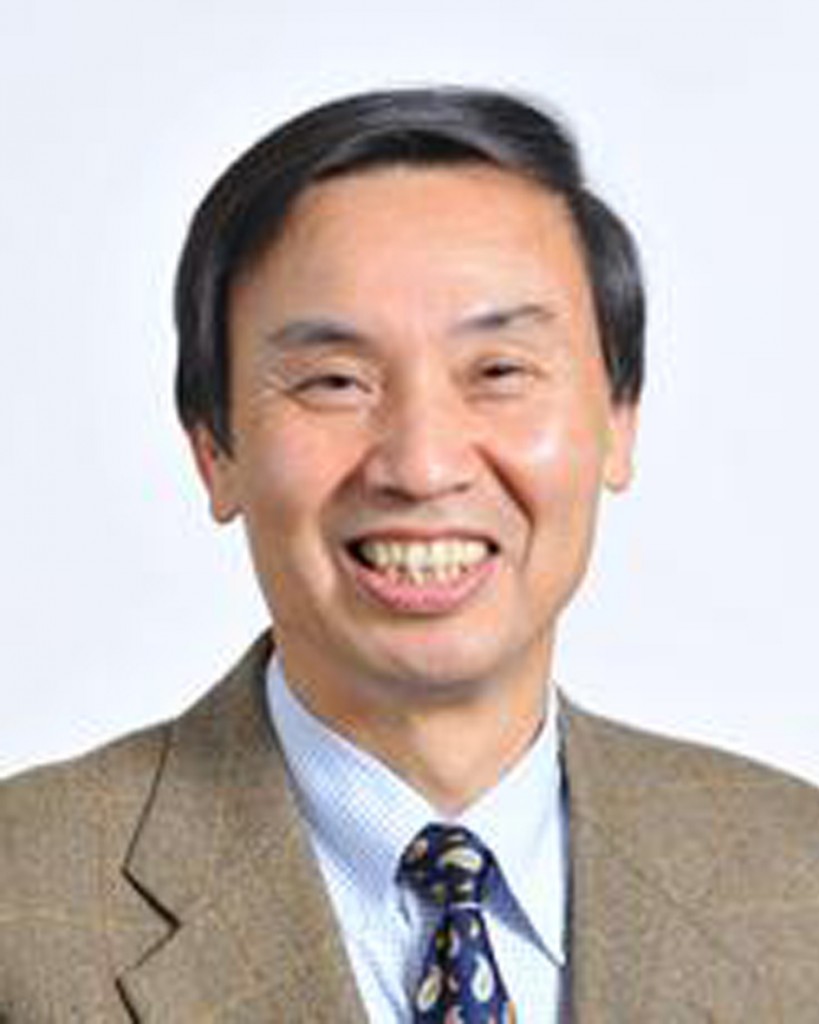

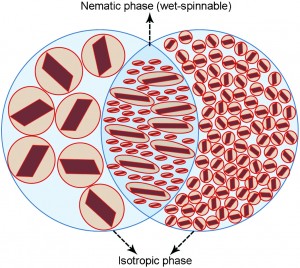
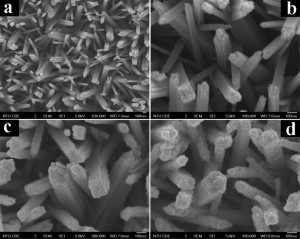
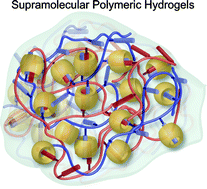
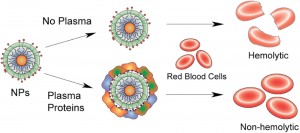
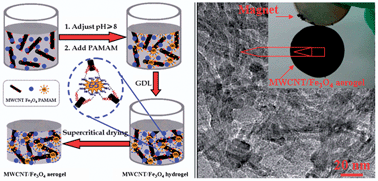
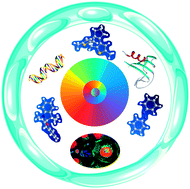 Photochromic materials are a family of compounds which undergo photo-reversible transformations between two different isomers with distinct physical and chemical properties. Most smart photochromic materials have been exploited in research areas such as electro-optical functional materials, while recently their applications have extended to novel bio-materials. Biological systems, such as tissue/cellular imaging, nucleotides, peptides, ion channels, etc., have emerged as a revolutionary research frontier for photochromic materials since both covalent coupling and non-covalent interactions with bio-molecules have been achieved. This review commences with a brief description of exciting progress in this field, and describes strategies for using photochromic functional molecules from bio-sensing and cell imaging to optical manipulation of bio-macromolecules (nucleotides, peptides, ion channels, GFP, etc.). Further development of these photo-switches as well as remaining challenges are also discussed and put in prospect.
Photochromic materials are a family of compounds which undergo photo-reversible transformations between two different isomers with distinct physical and chemical properties. Most smart photochromic materials have been exploited in research areas such as electro-optical functional materials, while recently their applications have extended to novel bio-materials. Biological systems, such as tissue/cellular imaging, nucleotides, peptides, ion channels, etc., have emerged as a revolutionary research frontier for photochromic materials since both covalent coupling and non-covalent interactions with bio-molecules have been achieved. This review commences with a brief description of exciting progress in this field, and describes strategies for using photochromic functional molecules from bio-sensing and cell imaging to optical manipulation of bio-macromolecules (nucleotides, peptides, ion channels, GFP, etc.). Further development of these photo-switches as well as remaining challenges are also discussed and put in prospect.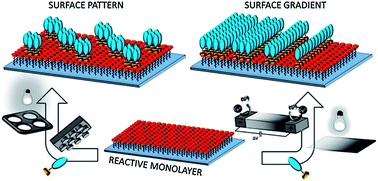 This review describes the progress of the development of surface chemical reactions for the modification of self-assembled monolayers (SAMs) and the fabrication of surface chemical gradients. Various chemical reactions can be carried out on SAMs to introduce new functionalities. “Click” reactions, which are highly efficient and selective, have largely contributed to the development and implementation of surface chemical reactions in the fields of biotechnology, drug discovery, materials science, polymer synthesis, and surface science. Besides full homogeneous functionalization, SAMs can be modified to exhibit a gradual variation of physicochemical properties in space. Surface-confined chemical reactions can be used for the fabrication of surface chemical gradients making the preparation of exceptionally versatile interfaces accessible.
This review describes the progress of the development of surface chemical reactions for the modification of self-assembled monolayers (SAMs) and the fabrication of surface chemical gradients. Various chemical reactions can be carried out on SAMs to introduce new functionalities. “Click” reactions, which are highly efficient and selective, have largely contributed to the development and implementation of surface chemical reactions in the fields of biotechnology, drug discovery, materials science, polymer synthesis, and surface science. Besides full homogeneous functionalization, SAMs can be modified to exhibit a gradual variation of physicochemical properties in space. Surface-confined chemical reactions can be used for the fabrication of surface chemical gradients making the preparation of exceptionally versatile interfaces accessible.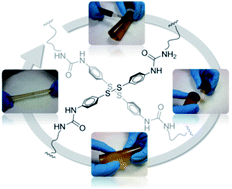
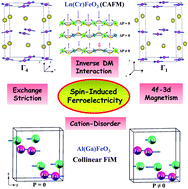 A few oxides such as YMnO3, TbMnO3, YMn2O5 and BiFeO3 constituted the small family of well-characterized multiferroics until recently, but this area of research has been enlarged significantly due to the advent of a novel class of oxides exhibiting interesting multiferroic and magnetoelectric properties arising from magnetically induced ferroelectricity. Interestingly, these materials are simple transition metal oxides, most of them possessing the perovskite structure. In this review article, we present the significant features of multiferroic and magnetoelectric ferrites and chromites which owe their ferroelectricity to magnetic interactions. Some of the important systems discussed are BiFeO3 whose properties are affected by magnetic and electric fields, rare-earth orthoferrites LnFeO3 (Ln = Dy, Gd and Sm) and rare-earth orthochromites LnCrO3, where exchange-striction plays a significant role. Perovskite oxides of the type Y(A1−xBx)O3 (A, B = Fe, Cr, Mn) exhibit multiferroic properties, although the existence of these properties in YFeO3 and YCrO3 is in doubt. Such oxides with a non-magnetic rare-earth cation at the A site and two transition metal ions in the B-site permit tuning the transition temperatures by varying the B site ions and their relative proportions or the Ln ion. Multiferroic properties of simple ferrites such as Al(Ga)FeO3 where cation disorder appears to play a role are also discussed. Problems and challenges in this area of research are indicated.
A few oxides such as YMnO3, TbMnO3, YMn2O5 and BiFeO3 constituted the small family of well-characterized multiferroics until recently, but this area of research has been enlarged significantly due to the advent of a novel class of oxides exhibiting interesting multiferroic and magnetoelectric properties arising from magnetically induced ferroelectricity. Interestingly, these materials are simple transition metal oxides, most of them possessing the perovskite structure. In this review article, we present the significant features of multiferroic and magnetoelectric ferrites and chromites which owe their ferroelectricity to magnetic interactions. Some of the important systems discussed are BiFeO3 whose properties are affected by magnetic and electric fields, rare-earth orthoferrites LnFeO3 (Ln = Dy, Gd and Sm) and rare-earth orthochromites LnCrO3, where exchange-striction plays a significant role. Perovskite oxides of the type Y(A1−xBx)O3 (A, B = Fe, Cr, Mn) exhibit multiferroic properties, although the existence of these properties in YFeO3 and YCrO3 is in doubt. Such oxides with a non-magnetic rare-earth cation at the A site and two transition metal ions in the B-site permit tuning the transition temperatures by varying the B site ions and their relative proportions or the Ln ion. Multiferroic properties of simple ferrites such as Al(Ga)FeO3 where cation disorder appears to play a role are also discussed. Problems and challenges in this area of research are indicated.